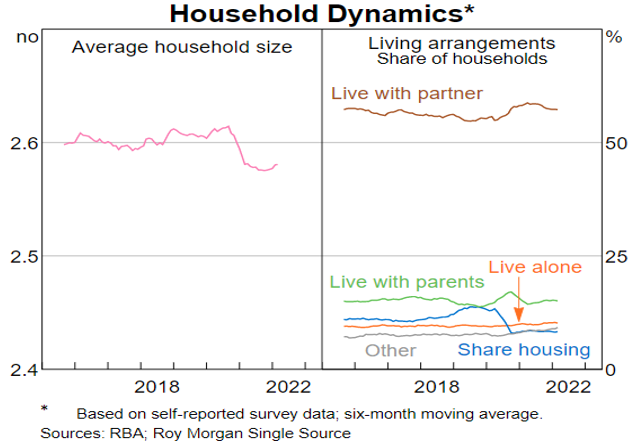Australia’s rental market tightened over the pandemic due to a desire for more space, the growing trend to working from home and the need for home offices.
This saw the number of people per dwelling fall sharply, in turn lifting rental demand despite sluggish population growth:

Rental supply also tightened via the rise of rental services like Airbnb, which enabled property owners to pivot to the short-term market.
With borders reopening, Australia has seen immigration rapidly rebound to pre-pandemic levels. And 2023 is expected to see the largest increase in net overseas migration (NOM) in this nation’s history, driven by a record rebound in international students.
Last week it was revealed that a record 360,000 visa applications were lodged overseas by students last year. The federal Government has also processed a record number of applications since the middle of 2022.
To add further insult to injury, Australia’s rental shortage will be further inflamed by the Chinese Government’s directive that it will no longer recognise foreign academic degrees and diplomas if the study was conducted online.
This decision is expected to see 40,000 to 50,000 Chinese students land in Australia over the next few months, equating to roughly one-third of available rentals in both Sydney and Melbourne.
With rents soaring by double-digit rates across the nation amid the tightest vacancy rates on record, REA Group Economist Anne Flaherty has reported a “very concerning” rise in people seeking share housing on the company’s flatmates.com.au website.
“What we’re seeing in the rental market is very concerning. Flatmates.com.au had its busiest January in its 30-year history with just shy of 70,000 new members joining”, Flaherty said.
“What we are seeing is the vast majority of members to the site are seeking a property as opposed to listing a property. And what this means is that there are far more people looking to live in a share house than there’s actually share houses available”.
Specific statistics coming from REA include:
- 50% of new members on flatmates.com.au in January were looking for accommodation, but only 13% were offering accommodation.
- The ratio of rents seekers to listers in Sydney is 16:1. Melbourne 23:1. Brisbane 86:1.
Flaherty warns that the rental crisis will inevitably get worse as immigration rises.
“We know that there is a shortage of traditional rental accommodation. We know now that there’s a shortage of share homes”.
“The total number of new construction starts has been steadily slowing down. It’s incredibly expensive and time consuming to develop at the moment. Yet our population is growing again. So, I don’t believe that we are going to see conditions improve anytime soon”.
“I think that this is going to become an even more critical issue particularly with our population now growing again”, Flaherty said.
The fact remains that so long as the federal government runs a ‘Big Australia’ immigration policy, the nation will forever suffer from housing shortages.
If policy makers genuinely want to fix Australia’s housing crisis, they must start by moderating population growth so that demand better matches supply.
Otherwise, Australia’s rental crisis will become a permanent feature of Australia.

